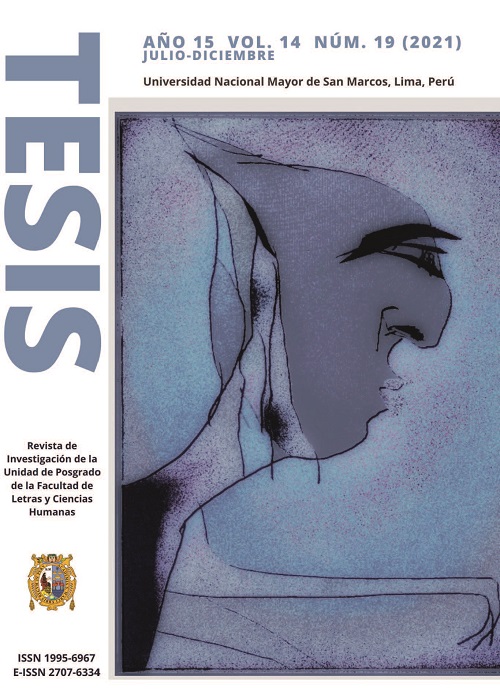Semiotic analysis of sexual eumphemisms and dysphemisms in Conversation in The Cathedral (1969), by Mario Vargas Llosa
DOI:
https://doi.org/10.15381/tesis.v14i19.20663Keywords:
Mario Vargas Llosa, semiotic, power relations, sexual euphemisms and dysphemismsAbstract
This research determines how the sexual euphemisms and dysphemisms enunciated by the characters in the novel Conversation in the Cathedral (1969), by Mario Vargas Llosa, operates as rhetorical instruments of intimidation and social coercion in the interlocutors. The image of the world that builds the speech of the peruvian nobel is also determined, as well as the figure of the narrator who has a tolerant and permissive vision with respect to non-heteronormative sexual behaviors. Finally, it is determined how power relations are, according to Foucault's (1982) proposal, which is why it is argued that they occur in the political, socioeconomic and sexual spheres. To carry out the study, the theoretical frameworks of the Semiotics of discourse, Tensive semiotics and the linguistic categories of euphemism, dysphemism, among others, are used.
References
Blanco, D. y Bueno, R. (1980). Metodología del análisis semiótico. Universidad de Lima.
Crespo, E. (2005). El eufemismo, el disfemismo y los procesos mixtos: la manipulación del referente en el lenguaje literario inglés desde mediados del siglo XXI hasta la actualidad. [Tesis de doctorado, Universidad de Alicante].
Foucault, M. (1988). El sujeto y el poder. Revista Mexicana de Sociología, 50(3), 3-20. https://terceridad.net/wordpress/wp-content/uploads/2011/10/
Foucault-M.-El-sujeto-y-el-poder.pdf
Fontanille, J. (2001). Semiótica del discurso. Universidad de Lima.
Fontanille, J. y Zilberberg, C. (2016). Tensión y significación. Fondo Editorial de la Universidad de Lima.
Greimas, A. J. (1989). Del sentido II. Gredos.
Quispe, Y. (2019). Los eufemismos en el ámbito sexual en las novelas de Mario Vargas Llosa: un análisis pragmático. [Tesis de licenciatura en Lingüística, Universidad Nacional Mayor de San Marcos]. https://bit.ly/2RIi06R
Quispe, Y. (2020). Estudio lexicográfico de los eufemismos sexuales novedosos en las novelas de Mario Vargas Llosa. Revista Zur, 2(1), 96-114. https://bit.ly/3hTVxyi
Ríos, G. (2011). El tabú y el disfemismo en jóvenes colegiales costarricenses. Revista Káñina, 35(1), 153-216. https://revistas.ucr.ac.cr/index.php/kanina/article/view/690
Vargas Llosa, M. (1969). Conversación en La Catedral. Alfaguara.
Warner, M. (1993). Fear of a queer planet/Queer politics and social theory. University of Minnesota Press.
Zilberberg, C. (2006). Semiótica tensiva. Fondo Editorial Universidad de Lima.
Downloads
Published
Issue
Section
License
Copyright (c) 2021 Yoselin Quispe Mendivil

This work is licensed under a Creative Commons Attribution 4.0 International License.
THE AUTHORS RETAIN THEIR RIGHTS:
(a) The authors retain their trademark and patent rights, and also on any process or procedure described in the article.
(b) The authors retain the right to share, copy, distribute, execute and publicly communicate the article published in Tesis (Lima) (in example, depositing the article in an institutional repository or publish it in a book), with recognition of its initial publication in the Tesis (Lima).
(c) The authors retain the right to make a later publication of their work, to use the article or any part of it (for example: a compilation of their works, notes for conferences, thesis, or for a book), provided that they indicate the source of publication (authors of the work, magazine, volume, number and date).






